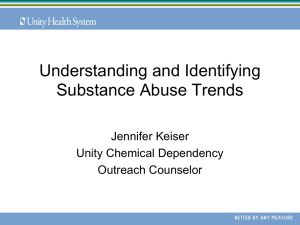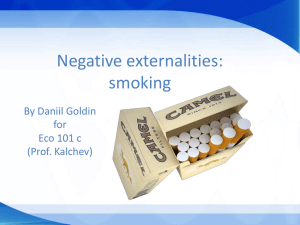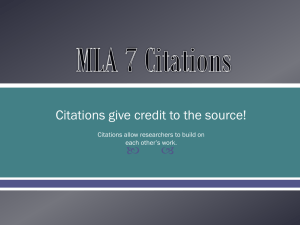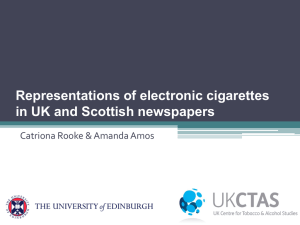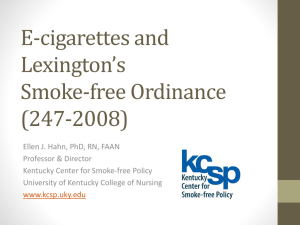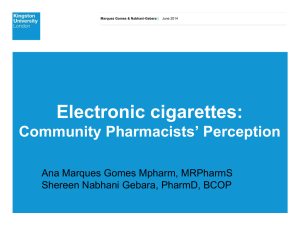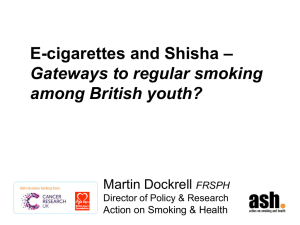to the presentation - UK National Smoking Cessation
advertisement
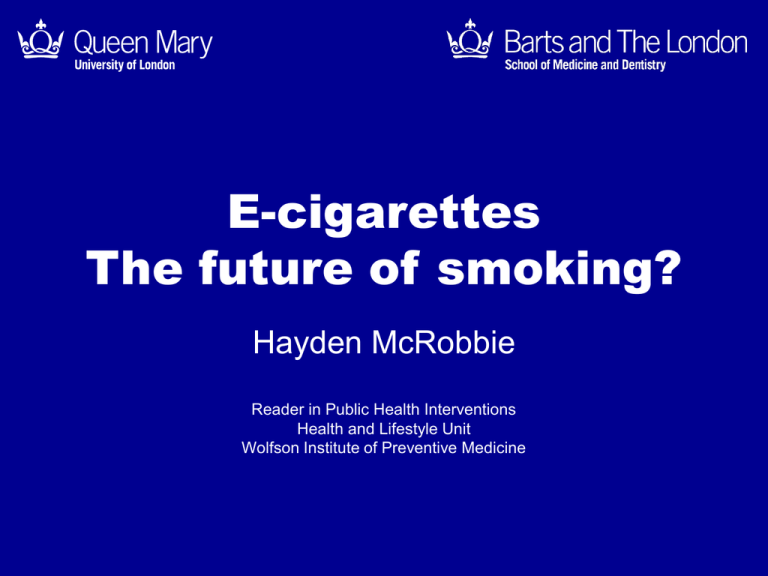
E-cigarettes The future of smoking? Hayden McRobbie Reader in Public Health Interventions Health and Lifestyle Unit Wolfson Institute of Preventive Medicine Declaration of Competing Interests • I am employed as a Reader in Public Health Interventions at Queen Mary University of London • I have received research funding from, and provided consultancy to manufacturers of smoking cessation medications • I was an co-investigator in a public-good funded ASCEND e-cigarette trial for which PGM International provided products at no cost, and have undertaken research on Ruyan e-cigarettes, for which the University of Auckland was funded by Health New Zealand, independently of Ruyan The current state of play • The majority of smokers want to quit • Smokers make frequent quit attempts • Smokers are looking for the next innovation to help them quit ARE E-CIGARETTES A GAME CHANGER? 1800’s Disruptive technology Pre-1880 1880 Gerry Stimson, Disruptive innovations: The rise of the electronic cigarette, International Journal of Drug Policy, May 2014 Increased consumption Increased production Increased consumption EC as a disruptive technology The survey conducted in 2014 found that electronic cigarette use amongst never smokers remains negligible. Only 1.1 per cent of never smokers have ever tried electronic cigarettes and virtually continue use them. Among former ASH Fact Sheet none (2014). Use of to electronic cigarettes in Greatsmokers, Britain 11.8 per cent have tried electronic CONCERN: UPTAKE IN CHILDREN AND NONSMOKERS Use by children (US) EVER use of electronic cigarettes – data from the National Youth Tobacco Survey 0.7% of never smokers 0.5% of never smokers COREY et al. (2013), Morbidity and Mortality Weekly Report, 62, 729-30. Use by children (UK) Electr oni c cg are tte u s a m og ch i lre n In 2013, two thirds of 11-18 year olds and f 83% eof 16-18 year aolds had heard g of electronic r n cigarettes. • Among children that have heard of electronic • Understa nding o e lc tro nic c i g r ettes a m o n chi l den is g e er a ly g oo d . Children who have heard of electronic cigarettes believe correctly that they are less harmful than cigarettes, use rare and confined to cigarettes to the regular user (74%) and those aroundis them (79%). Most (51%) 16-18 year olds r who have h heard of electronic o e cigarettes d believe l o that they contain t t nicotine. d • A mongo cil d re d n w h currently h a d v h e a rc o f ee c t rnic c ig e a r e t e e s , y su sta i n e u se is a re children who or use to smoke a nd cnfine t och i lre n who urr e nly or h a v p rviou sl sm ok ed . Of those who had heard of electronic cigarettes, 7% (10% among 16-18 year olds) had tried at least once. Two percent reported using them monthlyhaving or weekly . • Onlyelectronic 1%cigarettes of never smokers reported Among the 7% of children who reported some use of electronic cigarettes, only 28% used them in the last month. Of those who had never smoked a cigarette, 99% triedhad them “once or twice” reported never having tried electronic cigarettes and 1% reported having tried them “once or twice”. There is no evidence of regular electronic cigarette use among children who have never smoked or who have only tried smoking once. ASH Fact Sheet (2014). Use of electronic cigarettes in Great Britain A gateway to smoking? It’s difficult to make that conclusion when smoking prevalence is DECREASING US data show that around 40% of children try regular cigarettes.* *Johnston et al. Monitoring the Future national survey results on drug use, 1975-2012. Ann Arbor: Institute for Social Research, The University of Michigan; 2013; 2013. Report No.: Volume I: Secondary school student Nicotine use by never and ex smokers The survey conducted in 2014 found that electronic cigarette use amongst never smokers remains negligible. Only 1.1 per cent of never smokers have ever tried electronic cigarettes and virtually none continue to use them. Among former smokers, 11.8 per cent have tried electronic cigarettes but only 4.7 per cent use them on a regular basis. Smoking Toolkit Study www.smokinginengland.info N=8,380 from Nov 2013 3.5 3 2.5 2 1.5 1 0.5 0 Never Long-term smoker ex-smoker E-cig NRT ASH Fact Sheet (2014). Use of electronic cigarettes in 2 ASH Fact Sheet onGreat the use Britain of electronic cigarettes in Great Britain CONCERN: SAFETY Toxicants • A number of toxicants have been found in EC liquid, e.g. – acrolein and acetaldehyde – metal and silicate particles – tobacco-specific nitrosamines (TSNAs). • These are either at lower levels than seen in cigarette smoke or at levels that are not associated with health risk Burstyn 2014 BMC Public Health Goniewizc 2013 Tobacco Control EC nicotine delivery Not all products are the same 2.4% 2.4% 18mg Goniewicz, Hajek & McRobbie, 2014 Nicotine delivery in users • 20 smokers completed 6 x 10puff bouts (separated by 30 minutes) on an 18 mg/ml e-cig Vansickel et al Addiction 2012 • 8 experienced users (18-24 mg) Vansickel & Eissenberg Nicotine & Tobacco Research 2012 Different Devices Farsalinos et al, Sci. Rep. 2014 http://dx.doi.org/10.1038/srep0413 Safety in users • No SAEs related to EC in any study so far • AEs mostly irritation and cough, same in control conditions and in online forums on adverse effects • Several case reports (e.g. lipoid pneumonia, atrial fibrillation) • Increase in poison centre calls – most related to unintentional exposure – measures (e.g. childproof containers) to prevent accidental poisoning are warranted Exposures in perspective http://www.clivebates.com/?p=2197#p22 So far, so good • The general effects of long-term EC use are not known • There could be subtle chronic effects that become apparent only some time • We don’t know what these are or when they might appear (so makes it hard to study) • However any risks are likely to be a small fraction of the risks of smoking CONCERN: THEY MAY NOT HELP PEOPLE TO STOP SMOKING? Effects on smoking behaviour • EC reduces urges to smoke • EC use leads to reduced smoking and to smoking cessation in healthy smokers, even those not intending to quit; and in smokers with schizophrenia • EC with low nicotine vs. patches, no support: Similar small effect on cessation, but EC better on smoking reduction and user approval Smokers are already using them for smoking cessation (smokinginengland.info/latest-statistic) N=4,935 adults who smoke and tried to stop or who stopped in the past year Real-world effectiveness 5863 adults who had smoked within the previous 12 months and made at least one quit attempt during that period with either an e-cigarette only (n=464), NRT bought over-the-counter only (n=1922) or no aid in their most recent quit attempt (n=3477) 25% Self reported abstinence 20% 20.0% adj OR=1.61 (95% CI: 1.19-2.18) 15% 15.4% 10.1% 10% adj OR=1.63 (95% CI: 1.17-2.27) 5% 0% E-cigarette OTC NRT No aid Brown et al. Real-world effectiveness of e-cigarettes when used to aid smoking cessation: a cross-sectional population study. Addiction. 2014 May 20. doi: 10.1111/add.12623. [Epub ahead of print] User experience Would use an electronic cigarette to quit smoking Maybe 8% Would use an nicotine inhalator to quit smoking No 16% Yes 24% Yes 76% No 64% Maybe 12% Steinberg et al (2014). E-Cigarette Versus Nicotine Inhaler: Comparing the Perceptions and Experiences of Inhaled Nicotine Devices. J Gen Intern Med. CONCERN: DUAL USE Concerns: Dual Use • Concern that dual use might – Expose users to increased toxins – People may not stop smoking conventional cigarettes Dual use and toxins • In people who use both vape and smoke there are significant reductions in – Acrolein (a toxicant in tobacco smoke) – Carbon monoxide McRobbie H, Goniewicz M, Phillips A, Myers-Smith K, West O, Hajek P. Effects of the use of electronic cigarettes with and without concurrent smoking on acrolein delivery. Society for Research on Nicotine and Tobacco, 20th Annual Meeting, Seattle, Washington; 2014. Dual use and smoking behaviour 1. Increased duration of e-cigarette use increased the likelihood of being an ex-smoker (not dual use) 2. Duration of e-cigarette use was not associated with addiction to e-cigarette 3. The reported strength of e-cigarettes decreased from initiation to current use (this was not affected by duration of EC use of smoking history Lechner W V et al. Nicotine Tob Res 2014;ntr.ntu061 MAKING SENSE OF IT ALL Evaluating harm • • • • • • • • • • • Cigarettes Cigars Little and small cigars Pipes Water pipe Smokeless (non-snus) tobacco Snus E-cigarettes (ENDS) Oral nicotine products Patch Nasal spray Estimating the Harms of Nicotine-Containing Products Using the MCDA Approach Nutt, Phillips, Balfour, Curran, Dockrell, Foulds, Fagerstrom, Letlape, Milton, Polosa, Ramsey, Sweanor. Eur Addict Res 2014;20:218-225 Estimating the Harms of Nicotine-Containing Products Using the MCDA Approach Nutt, Phillips, Balfour, Curran, Dockrell, Foulds, Fagerstrom, Letlape, Milton, Polosa, Ramsey, Sweanor. Eur Addict Res 2014;20:218-225 The Precautionary Principle • Based on an examination of the potential benefits and costs of action or lack of action • Subject to review, in the light of new scientific data When the facts change, I change my mind. What do you do, Sir? John Maynard Keynes European Commission (2000) Communication from the Commission on the precautionary principle http://eur-lex.europa.eu/LexUriServ/LexUriServ.do?uri=COM:2000:0001:FIN:EN:PDF CURRENT RECOMMENDATIONS FOR PRACTICE Guidance • Be open to electronic cigarette use in people keen to try them, especially in those who have tried and failed using other aids • Provide advice to clients http://www.ncsct.co.uk/usr/pub/e-cigarette_briefing.pdf Giving advice • EC provide some of the nicotine that a smoker would have otherwise obtained from smoking regular cigarettes • EC are not a magic cure, but some people find them helpful • There is a wide range of EC available and clients may need to try various brands, flavours and nicotine dosages before they find a brand that they like • EC use is not exactly like smoking and users may need to experiment and learn to use them effectively • Although some health risks from EC use may yet emerge, these are likely to be, at worst, only a small fraction of the risks of smoking News (http://www.scotsm (http://www.scotsm an.com /) an.com /news) What's On (http://www.scotsm an.com /what-s-on) Directory (http://www.scotsm an.com /findit) A change Sport (http://www.scotsm an.com /sport ) Business (http://www.scotsm an.com /business) Lifestyle (http://www.scotsm an.com /lifestyle) Motors (http://www.scotsm an.com /motors) Deals (http://www.dealmonster.co.uk/deal/edinburgh/ ) More Jobs (http://www.scotsm an.com /jobs) Property (http://www.scotsm an.com /property) (http://www.scotsman.com /) Health experts back e-cigarettes to quit smoking bbyy LLY YN ND DS SA AY YB BU UC CK KLLA AN ND D ELECTRONIC cigaret t es have been included for t he fi r st t im e in offi cial NHS Scot land guidance aim ed at helping sm okers quit . The new advice recognises the increased popularity of the sm oking simulators am ong people wishing to cut down their use of m ore harm ful tobacco products. It says that while those using NHS sm oking cessation services should be strongly encouraged to adopt licenced nicotine replacem ent therapy (NRT), such as patches and gum , those wanting to use e-cigarettes should not be told to stop if there was a risk they would return to tobacco. • “…those wanting to use e-cigarettes should not be told to stop if there was a risk they would return to tobacco. In the past it is believed some services have turned away those wanting to use ecigarettes as part of their attempts to quit smoking, meaning they are denied other forms of support offered by the NHS such as group counselling.” EC friendly services • Leicester Stop Smoking Service supporting people quitting with the aid of EC Concluding remarks • We should not forget the goal of tobacco control, which is ultimately to save lives • Most people who smoke are desperate to quit • EC have become a popular stop smoking aid • So far there is little evidence for the hypothetical risks and increasing evidence for benefits • Appropriate cautionary measures can be still be applied (e.g. sales to minors, consumer safety, surveillance) without regulation that would impede further development Fanaticism consists of redoubling your effort when you have forgotten your aim. (George Santayana) Concluding remarks • Stop smoking services still provide the best support for stopping smoking • Stop smoking practitioners now have an opportunity to – support people using EC through their quit attempt – provide advice based on the current evidence – collect information that may inform future policy – learn from clients using these devices

